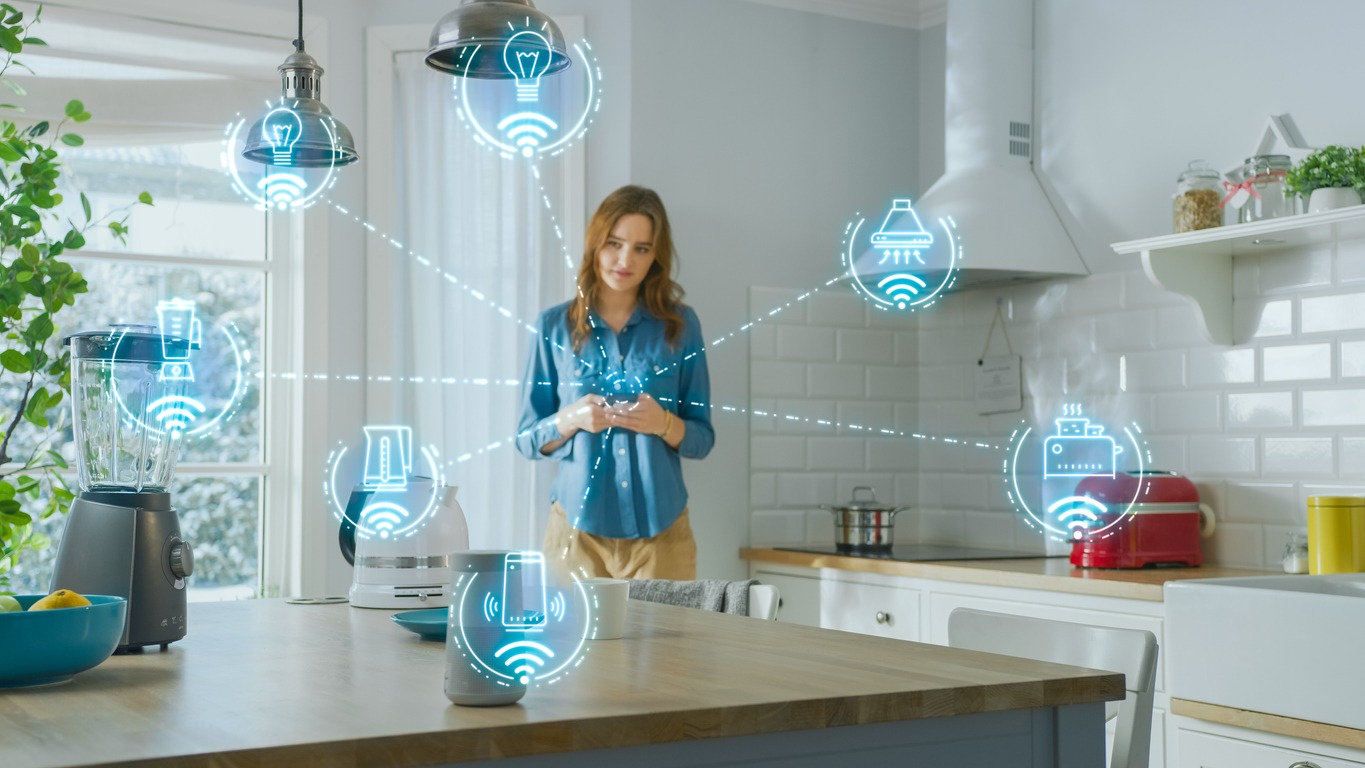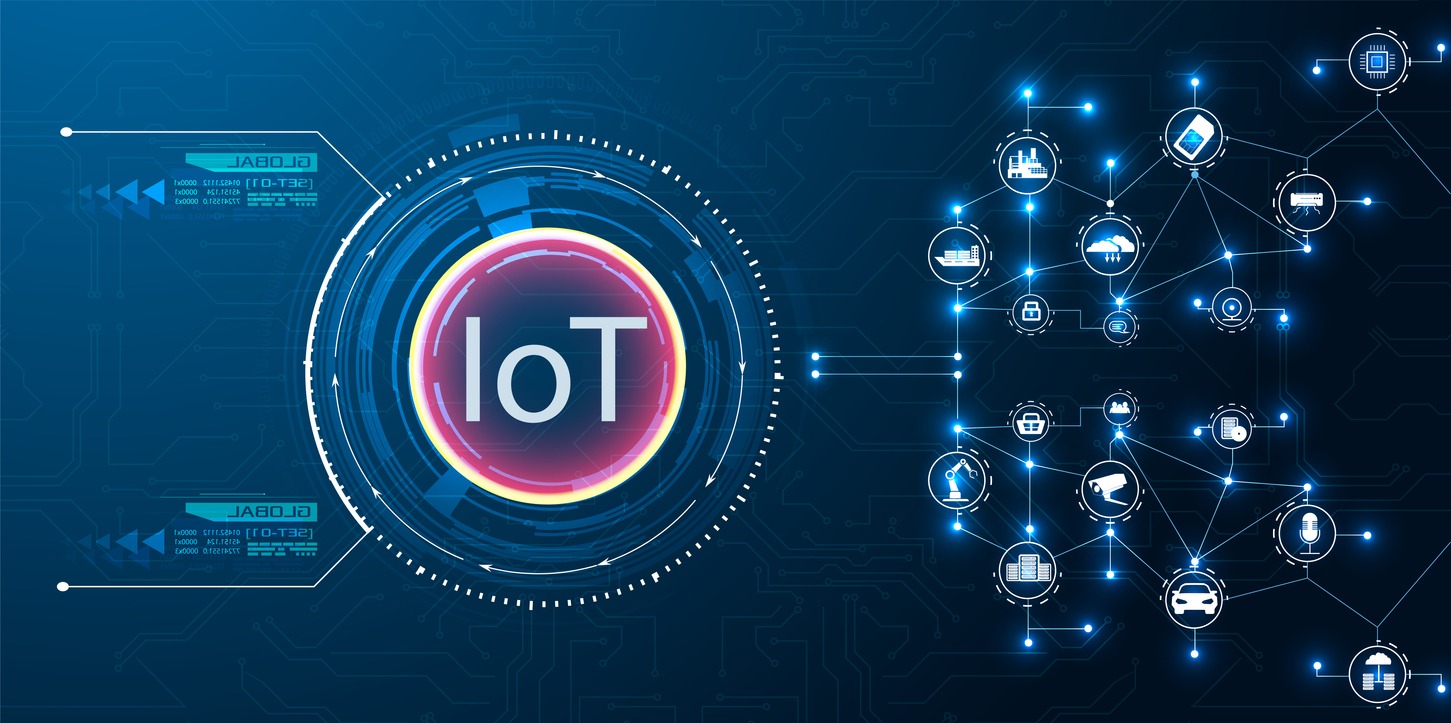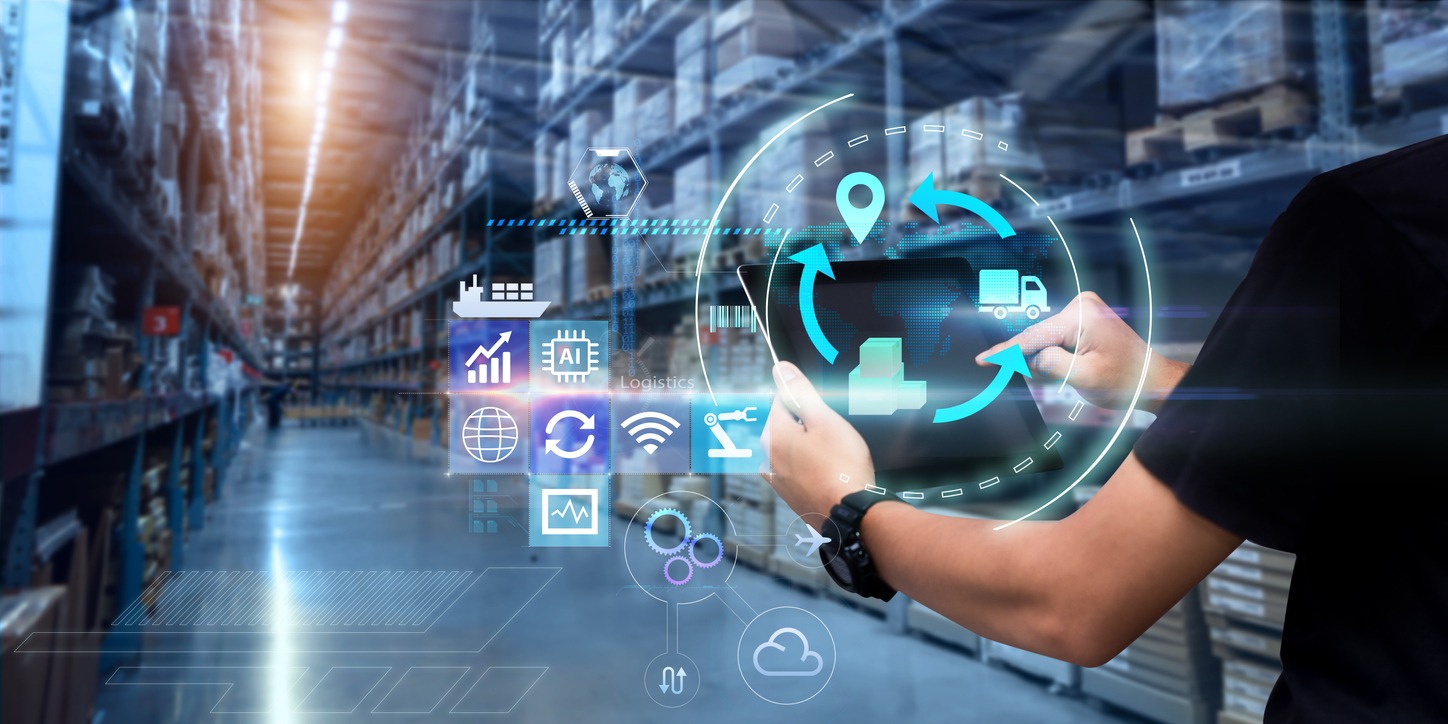Do you have a smart thermostat at home, or do you use smart speakers to turn off your lights? Perhaps you own a fitness tracker that you always wear to the gym or when working out. Or do you have a smart appliance that you can control using an app installed in your smartphone? If you do, you are already part of the internet of things, or IoT.
What is the Internet of Things (IoT)?
The internet of things, or IoT, is a network of devices that connect and exchange data with each other and the cloud. It’s a network of physical objects, devices, vehicles, buildings, and other items that are embedded with sensors, software, and network connectivity. These “things” are capable of collecting and exchanging data over the internet, enabling them to interact with each other and with humans.
IoT relies on technology that links the physical and digital worlds. Objects get sensors to keep an eye on things like temperature or movement, and they can respond to changes through actuators. These sensors and actuators talk to computers through wired or wireless connections. And they aren’t limited to man-made things; nature, people, and animals can be part of IoT too.
It involves countless devices worldwide that connect to the internet, gathering and sharing data. Thanks to tiny, affordable computer chips and widespread wireless networks, almost anything, from a tiny pill to a massive airplane, can join the IoT. By adding sensors and connecting these objects, they become smart and can communicate data without human involvement. This makes our world smarter and more responsive, bridging the gap between the digital and physical realms.
With IoT, data moves over networks without people having to do everything. Think about a smart thermostat at home or a fitness tracker you use to stay healthy. These are part of IoT, which has become a big part of our lives and how businesses work. Businesses are using IoT to work better, serve customers, make smarter decisions, and grow.
The beauty of IoT is that it’s always connected, combined with data and analysis, opening up new opportunities for businesses to create better products, services, and run more efficiently.
IoT has a wide range of applications and benefits, such as improving efficiency, automation, and convenience in various industries. For example, it can help optimize energy consumption in smart homes, enhance predictive maintenance in manufacturing, enable precision agriculture, and enhance healthcare monitoring.
IoT has been one of the most significant trends in business and technology in recent years.
How Does IoT Work?
To understand how IoT works, you have to know its key components. The key components of IoT include:
1. Things or Devices: These are the physical objects or devices that have been enhanced with sensors, processors, actuators, and network connectivity. Examples include smart thermostats, wearable fitness trackers, Wi-Fi integrated appliances, industrial machinery, and even smart cities infrastructure.
2. Connectivity: IoT devices are connected to the internet or other communication networks, allowing them to transmit and receive data. This can be done through various means, including Wi-Fi, cellular networks, Bluetooth, and low-power, long-range networks designed specifically for IoT (e.g., LoRaWAN).
3. Data Processing: IoT devices collect data from their surroundings using sensors (e.g., temperature, humidity, motion, GPS) and process this data to extract meaningful information. Some devices can perform basic data processing locally, while others rely on cloud-based servers for more complex analysis.
4. Cloud Services: The data collected by IoT devices is often sent to cloud-based services for storage, analysis, and processing. These services can provide a centralized platform for managing and monitoring multiple devices and can host applications that enable data analysis, visualization, and control.
Before the data is shared, it is also sent to an edge device where that data is locally analyzed to reduce the volume of data sent to the cloud, minimizing bandwidth consumption.
The way these devices communicate with other related devices and the internet and how they act on the gathered information depends on the job they’re doing. There’s no one-size-fits-all, so they use different ways to stay connected.
What Makes IoT Possible?
While the idea of the internet of things has been existing for a long time, recent technological advances has made it practical and widespread, such as:
Low-cost, low-power sensors: These dependable sensors are like the eyes and ears of IoT, allowing gadgets to sense and share info. Since they have become affordable, more manufacturers have integrated them into their products.
Connectivity: The internet has an array of network protocols, making it easy to hook up sensors to the cloud and other devices for smooth and efficient data transfer.
Cloud computing platform: Thanks to cloud platforms, both businesses and regular people can access the computer infrastructure they need without having to manage all the nitty-gritty tech stuff.
Smart analytics and machine learning: With advancements in analytics and machine learning – as well as access to various and vast amounts of data stored in the cloud – businesses can gather insights quickly. These technologies continue to push the boundaries of IoT and the data it can produce.
Conversational artificial intelligence: The rise of neural networks has given us AI that can chat naturally. Think of Alexa, Cortana, Siri, and more – these are AI integrated with natural-language processing (NLP), which makes IoT devices appealing, user-friendly, and viable for home use.
Why is IoT Essential?
IoT is all about making life smarter and work easier. Think of your smartwatch, car, or thermostat – they’re all part of IoT. They are designed to improve your daily routine. Imagine your garage door automatically opening as you drive home, your thermostat setting the perfect temperature, and your lights dimming just right when you get home. Once we had a taste of these daily conveniences, we won’t want to go back.
Besides these offerings for individuals and homes, IoT is a game-changer for businesses too. It gives them a real-time peek into how their systems work, delivering insights from machines to supply chains. It even lets machines do tedious tasks on their own, which means less work for humans. That means lower labor costs, less waste, and better service. Plus, it makes producing and delivering stuff cheaper and more transparent. All in all, it allows businesses to make better decisions and generate more revenue.
IoT is one of the most important things in tech right now, and it keeps getting better as more businesses realize how it can keep them ahead of the game. It’s all about connecting the real world to the digital one, and making them work together seamlessly.
Consumer and Business Applications of IoT
There are many real-world applications of the internet of things. Let’s talk about how IoT makes a difference, both for consumers and businesses:
1. Smart Homes: Today, smart homes are equipped with smart appliances, smart thermostats, and connected heating, lighting and electronic devices that can be remotely controlled using smartphones, computers, or smart voice assistants like Amazon Echo.
2. Wearable Devices: Wearable devices like smartwatches and fitness trackers are nifty devices with sensors make your life easier. They collect data about you and share it with other tech to make your life more comfortable. They’re also used for public safety, like helping first responders find you quickly in an emergency.
3. Healthcare: IoT lets doctors keep a closer eye on patients by analyzing their data. Hospitals use it for things like managing medicines and medical instruments.
4. Smart Buildings: Buildings can be smarter, too. For example, they can use sensors to figure out how many people are inside and adjust the temperature accordingly. No more freezing in an empty conference room!
5. Manufacturing: Manufacturers can use production-line monitoring to enable proactive equipment maintenance when sensors detect impending failure. Sensors can also measure when the production output is compromised. This can help reduce operating costs, improve asset management, and keep things running smoothly.
6. Automotive: In the car world, IoT helps with production and manufacturing. Sensors installed in cars can also detect impending equipment failure so it can alert driver with details and recommendations. It can also help manufacturers and suppliers learn about how to keep cars running in shape.
7. Transportation and Logistics: IoT helps with planning and rerouting vehicles based on weather, vehicle availability, and driver schedules. It’s also super handy for keeping an eye on temperature-sensitive cargo.
8. Farming: IoT helps farmers by monitoring stuff like light, temperature, humidity, and soil moisture with sensors. It’s also great for automating irrigation systems.
9. Smart Cities: In a smart city, you’ve got sensors in streetlights and meters that help reduce traffic, save energy, protect the environment, and keep things clean.
10. Retail: Retailers use IoT to manage inventory, improve the shopping experience, and keep their supply chain optimized. For example, smart shelves tell them when they’re running low on products and beacons offer targeted deals to customers.
11. Public Sector: Government-owned services can use IoT to inform people about power or water outages. It helps with disaster recovery and keeping things running smoothly.
12. Outdoor Settings: In urban environments and other outdoor settings such as flight navigation, railroad tracks or autonomous vehicles, IoT can help with real-time routing, shipment tracking, and connected navigation.
13. Custom Work Environments: In custom settings like mines, construction, or oil rigs, IoT can be used in predictive maintenance and health and safety efforts.
14. General Safety in All Industries: In dangerous workplaces like mines or chemical plants, IoT keeps workers safe by alerting them about hazards via connection to IoT sensor-based applications. It also helps monitor people’s health and the environment, even from a distance.
Pros and Cons of IoT
Advantages of IoT
Some of the pros of IoT include the following:
1. Access to info everywhere: You can get info from your devices wherever, whenever, and on any gadget.
2. Better device communication: IoT makes your electronic devices communicate seamlessly.
3. Saving time and money: Data can travel over networks smoothly, saving precious time and money.
4. Data gathering abilities: IoT can collect heaps of data from different gadgets, which helps both users and manufacturers.
5. Smart analysis: It can crunch data right where it’s collected, so you don’t send all of it to the cloud.
6. Automation: Tasks can be done automatically, which makes services better and reduces the need for human intervention.
7. Healthcare aid: It enables patients to be cared for continually and more effectively.
Disadvantages of IoT
IoT poses some cons to users, too, such as:
1. Security risk: IoT raises concerns about data privacy, security, and the potential for misuse of the vast amount of data generated by connected devices. As the number of devices connected increase, the potential for a hacker to get confidential information increases. As IoT continues to grow, addressing these challenges becomes increasingly important.
2. Privacy risk: But it’s not just hackers you need to worry about; your privacy is at risk too. Companies that make IoT gadgets might use them to get your personal data and sell it. So, when it comes to IoT, keeping your stuff safe and private is a pretty big deal!
3. Devices can pile-up: Device management gets trickier as the number of IoT gadgets pile up. Organizations may eventually have to deal with the massive number of IoT devices that collect and manage data simultaneously.
4. Bugs in the system: Tech isn’t always perfect – if there’s a glitch in the system, it has the potential to corrupt connected devices.
5. Compatibility issues: Different devices are not always compatible, as there are no international standard of compatibility for IoT. This makes it hard for devices from different brands and manufacturers to communicate with each other.
History of IoT
The concept of having a network of smart devices was introduced way back in 1982 when computer scientists at Carnegie Mellon University hooked up a Coca-Cola vending machine to the ARPANET. This clever machine could tell people if it had cold drinks and how many were left.
IoT grew from machine-to-machine (M2M) communication, where machines connected to each other without human interaction. M2M connects devices to the cloud, manages them, and collects data. IoT takes it to the next level with billions of smart devices, linking people, systems, and applications to share data. M2M offered the connectivity that enables IoT.
It’s also an evolution of supervisory control and data acquisition (SCADA), which controls processes and collects real-time data. SCADA systems, which included hardware and software components, gathered data and feeds it to a desktop computer with SCADA software, and then is processed and presented in a timely manner. Late generation SCADA systems were integrated into first-generation IoTs.
Fast forward to the ’90s, and experts like Mark Weiser were pioneering concepts like “ubiquitous computing” in 1991. In 1994, an article in IEEE Spectrum described the concept of moving small packets of data to loads of devices, making everything from home gadgets to entire factories smarter.
Companies like Microsoft and Novell were throwing around ideas in the mid-’90s, but it was Bill Joy who really kicked things into gear with his “Six Webs” concept in 1999, which includes device-to-device communication.
The term “Internet of things” got its start in a 1985 speech by Peter T. Lewis, but it didn’t really take off until 1999 when Kevin Ashton used the term during a presentation to Procter & Gamble. He liked to call it the “Internet for things” and saw RFID as a key part of it. In 1999, MIT professor Neil Gershenfeld also gave us a glimpse of the IoT future with his book “When Things Start to Think.”
By 2004, smart folks were already predicting that IoT devices would take over. Cornelius “Pete” Peterson, CEO of NetSilicon, predicted that they’d become even more popular than regular computers, and that medical devices and industrial controls would become its dominant applications.
Cisco Systems says the IoT was born between 2008 and 2009 when the number of connected things surpassed the number of people.
From 2010 to 2019, IoT became a part of our daily lives. Smartphones, smart TVs, and other connected devices started connecting to one other.
By 2020, IoT devices were everywhere, using various networks like 2G, 3G, 4G, 5G, LoRaWAN, and LTE-M. In 2023, billions of IoT devices gather and share data for consumers and industries. IoT plays a big role in creating digital twins, virtual copies of real-world things, and healthcare has embraced it with wearables and remote monitoring.
Conclusion
The Internet of Things (IoT) has transformed the way we live and work, creating a connected world where everyday objects communicate and collaborate to enhance our lives. As we’ve seen, IoT’s roots stretch back to early concepts in the ’80s and ’90s, with pioneers like Kevin Ashton and Bill Joy setting the stage. It has thrived thanks to technological advancements, from low-cost sensors and robust connectivity to the power of cloud computing and machine learning.
IoT has ushered in a new era that enabled us to monitor our health, optimize our homes, and improve industries from manufacturing to healthcare. It’s not just a technological revolution – it’s a lifestyle revolution, and it’s here to stay.



